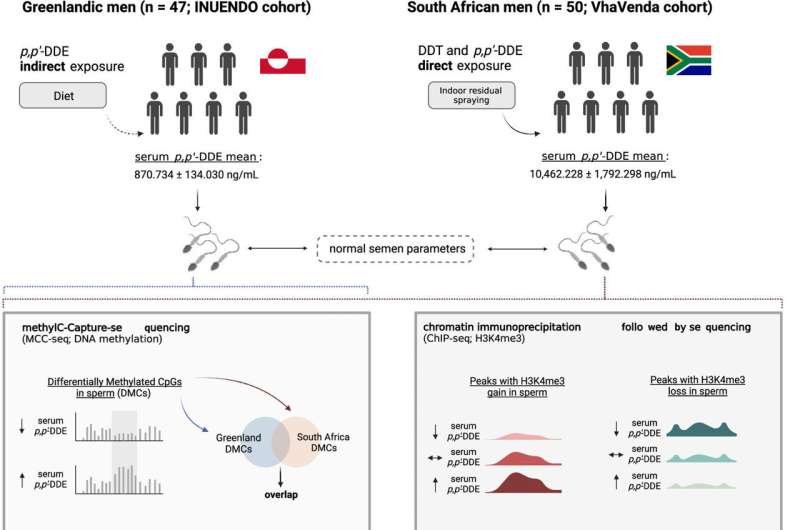This article has been reviewed according to Science X's editorial process and policies. Editors have highlighted the following attributes while ensuring the content's credibility:
fact-checked
trusted source
proofread
Are environmental toxins reducing men's fertility?

In a study that signals potential reproductive and health complications in humans, now and for future generations, researchers from McGill University, the University of Pretoria, Université Laval, Aarhus University, and the University of Copenhagen, have concluded that fathers exposed to environmental toxins, notably DDT, may produce sperm with health consequences for their children.
The decade-long research project examined the impact of DDT on the sperm epigenome of South African Vhavenda and Greenlandic Inuit men, some of whom live in Canada's North.
The study, published in the journal Environmental Health Perspectives, demonstrates a link between long-term exposure to DDT and changes in the sperm epigenome. These changes, particularly in genes vital for fertility, embryo development, neurodevelopment, and hormone regulation, correspond to increased rates of birth defects and diseases, including neurodevelopmental and metabolic disorders.
"We identified regions of the sperm epigenome that are associated with the serum levels of DDE (chemicals that form when DDT breaks down), and this association follows a dose-response trend. I think that's quite striking, in that the more DDE you're exposed to, the higher the chromatin, or DNA methylation defects are in the sperm," said Ariane Lismer, Ph.D., the study's lead author, who completed the work while pursuing her Ph.D. at McGill's Department of Pharmacology and Therapeutics.
"We demonstrate the sperm epigenome's response to toxin exposures may be linked with disease in the next generation," said Sarah Kimmins, Ph.D., who led the research as Professor of Pharmacology and Therapeutics at McGill and is also now a professor in the Department of Pathology and Cell Biology at Université de Montréal. "This is a critical new step for the field because while there are many studies of animals demonstrating toxin effects on the sperm epigenome, studies in humans have not comprehensively demonstrated this."
Malaria, climate change, and the 'grasshopper effect'
Despite a global ban on DDT to protect humans and the environment from its effects, the South African government has special permission to use it as an insecticide to control malaria. In some areas, home interiors are coated with the toxin. The study's findings underscore the urgency to find alternative ways to control malaria and other vector-borne diseases.
"The reality is that people, especially young children and pregnant women, are still dying from malaria. We cannot afford for people in malaria-endemic regions to refuse spraying of their houses, as it will increase their risk of getting malaria," says Tiaan de Jager, Ph.D., Dean of the Faculty of Health Sciences and Professor in Environmental Health at the School of Health Systems and Public Health at the University of Pretoria.
Moreover, the number of people and animals exposed to DDT is reportedly increasing due to climate change. DDT can travel vast distances through what is known as the "grasshopper effect," evaporating with warm air and returning to Earth with rain and snow in colder regions, where it persists in the Arctic food chain.
Rethinking fathers' role in child development
The findings also highlight the importance of considering fathers in discussions about child health and development. While it's commonly understood that women should avoid exposure to environmental contaminants during pregnancy, less attention has been given to how toxins affect fathers.
"We tend to think all fathers have to do is fertilize. But in fact, we forget that half of that genome and epigenome comes from the fathers, and half of it comes from the mothers. What that epigenome does in embryo development is critical for normal development," says study co-author Janice Bailey, Ph.D., formerly Professor of Animal Sciences at Université Laval and now the Scientific Director at Fonds de Recherche du Québec en Nature et Technologies (FRQNT).
Although the study focuses on DDT exposures, the researchers say it is not a leap to suggest that exposures to more common household endocrine disruptors, such as those found in cosmetics and personal care items, may act similarly.
More information: Ariane Lismer et al, The Association between Long-Term DDT or DDE Exposures and an Altered Sperm Epigenome—a Cross-Sectional Study of Greenlandic Inuit and South African VhaVenda Men, Environmental Health Perspectives (2024). DOI: 10.1289/EHP12013

















